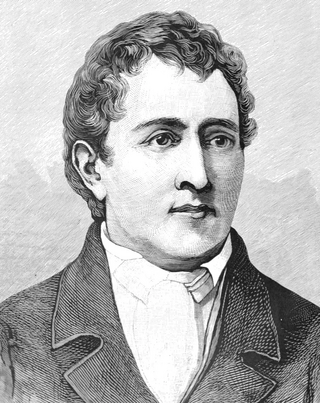
Carl Wilhelm Scheele was a German Swedish pharmaceutical chemist.
The year 1780 in science and technology involved some significant events.

Epacris is a genus of about forty species of flowering plants in the family Ericaceae. It was formerly treated in a closely related but separate family Epacridaceae, but the various genera within Epacridaceae including Epacris have been revised in their relationships to each other and brought under the common umbrella of the Ericaceae. The genus Epacris is native to eastern and southeastern Australia, New Caledonia and New Zealand. The species are known as heaths or Australian heaths.

Pimelea, commonly known as rice flowers, is a genus of plants belonging to the family Thymelaeaceae. There are about 150 species, including 110 in Australia and 36 in New Zealand.

Ehrharta is a genus of plants in the grass family.
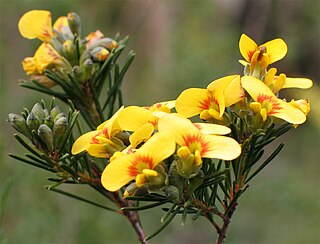
Dillwynia is a genus of about 20 species of flowering plants in the family Fabaceae, and is endemic to Australia. Plants in this genus are shrubs with simple leaves and yellow or red and yellow flowers similar to others in the family.

Sphaerolobium is a genus of flowering plants in the family Fabaceae and is endemic to Australia, occurring in all states and territories except the Northern Territory. Species of Sphaerolobium are erect shrubs, usually with rush-like stems and yellow or red flowers similar to others in the family.
Litophasia is a genus of flies in the family Tachinidae.

Dendrobium linguiforme, commonly known as the thumbnail orchid, tick orchid or tongue orchid, is a plant in the orchid family Orchidaceae and is endemic to eastern Australia. It grows on trees or on rocks, with wiry, prostrate stems, prostrate, fleshy leaves and spikes of up to twenty white to cream-coloured flowers in early spring.

Gyalecta is a genus of lichen-forming fungi in the family Gyalectaceae that contains 50 species. Gyalecta was circumscribed by lichenologist Erik Acharius in 1808. It forms associations with Trentepohlia algae.

Gnarosophia bellendenkerensis is a species of air-breathing land snail, a terrestrial pulmonate gastropod mollusk in the family Camaenidae.

Inquisitor sexradiata is a species of sea snail, a marine gastropod mollusk in the family Pseudomelatomidae.
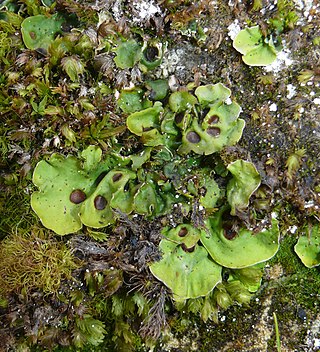
Solorina is a genus of 10 species of lichenized fungi in the family Peltigeraceae. The genus was first described by the Swedish botanist Erik Acharius in 1808. Members of the genus are commonly called socket lichens.

Grubbia is a genus of flowering plants. It is the sole genus in the family Grubbiaceae. The genus has three species, all endemic to the Cape Floristic Region of South Africa. They are shrubs that grow to 1.5 m (4.9 ft) tall, with tiny flowers and slender, leathery leaves. The fruit is a syncarp.
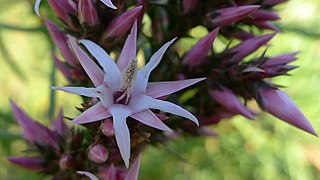
Sprengelia incarnata, commonly referred to as pink swamp-heath, is a species of flowering plant of the family Ericaceae, and is native to south-eastern Australia and New Zealand. It is an erect, glabrous shrub with sharply-pointed, stem-clasping, egg-shaped leaves, and clusters of pink, tube-shaped flowers with spreading lobes.
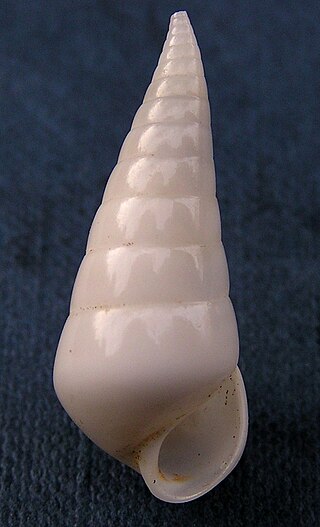
Melanella martinii, common name the white parasitic snail, is a species of sea snail, a marine gastropod mollusk in the family Eulimidae.
Eucithara vittata is a small sea snail, a marine gastropod mollusk in the family Mangeliidae.
Daniel Erik (Eric) Næzén, was a Swedish provincial physician, engraver, composer and natural scientist. In his youth Næzén was a founder member, on 13 December 1769, of the Swedish Topographical Society in Skara alongside parish priest and naturalist Clas Bjerkander, Anders Dahl, Johan Abraham, entomologist Leonard Gyllenhaal, chemist Johan Afzelius and Olof Knös. The members reported on plant and animal life, geography, topography, historical monuments and economic life, mostly in the Västergötland area. From 1770, Næzén studied in Uppsala, where in April 1782 he gained his licentiate of medicine. He studied under Carl von Linné. In July 1782 he became a provincial physician in Umeå. As a natural scientist, he contributed entomological papers to the Academy of Sciences journals. And also for the science academy he, from 1796 until his death, made meteorological observations in Umeå. Næzén left a comprehensive collection of insects, plants and minerals. Næzén studied at the Musical Academy in 1773 and was an amateur musician and amateur composer. He was elected as member 124 of the Royal Music Academy on 18 December 1790 and by the Royal Academy of Sciences in 1793.

Umbilicaria hyperborea, commonly known as blistered rock tripe, is a species of foliose lichen in the family Umbilicariaceae. It is widely distributed in arctic and alpine regions.

Peperomia turbinata is a species of flowering plant from the genus Peperomia. It was first described by Gustav Adolf Hugo Dahlstedt and published in the book "Kongliga Svenska Vetenskaps Academiens Handlingar 33(2): 88. 1900". The species name came from the Latin word "turbinatus", which means cone-headed.
















